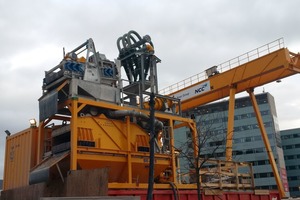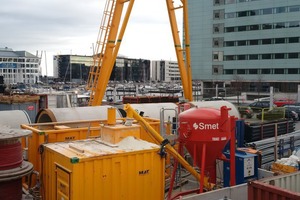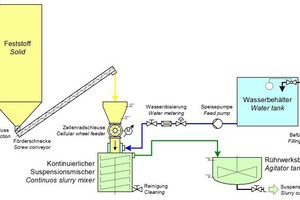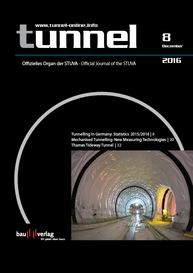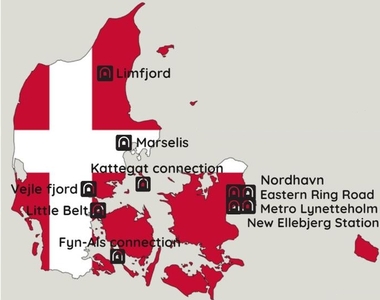MAT Materials Preparation Technology for Microtunnelling Project below the Port of Copenhagen
Copenhagen is the political and economic core of Denmark; it is the capital and the seat of government. Like most of Europe’s capitals it also suffers from space constraints and tricky traffic conditions, something which makes executing major construction measures a real infrastructural challenge.As HOFOR Fjernvarme P/S, the local energy provider in Copenhagen, invited tenders for the “Distance-heating Tunnel under the Port of Copenhagen” in May 2014, the particular local conditions within the city centre had to be taken into consideration. Furthermore, the needs of a modern and environmentally-sensitive capital city like Copenhagen had to be considered above all, for setting up the construction site and the disposal concept.
Distance-heating Tunnel
produced by Microtunnelling
The object of the construction measure was the construction of a distance-heating tunnel under the Port of Copenhagen at a depth of some 24 m with 3 m internal diameter, given an external diameter of 3.6 m. The total column length amounted to 321 m. The geology to be expected involved limestone and flintstone with a rock compressive strength of up to 30–40 Mpa. The flushing system to transport the material was operated at roughly 200–250 m³/h.
At the end of August 2014, the NCC/SMET Consortium was commissioned to undertake the project and the “Distance-heating Tunnel under the Port of Copenhagen” scheme was successfully completed in January 2016. The NCC is a leading construction company from Sweden, which is also actively engaged in Denmark. The company of SMET Tunnelling N.V. has its headquarters in Belgium and has specialised in the field of mechanised tunnelling for decades on end.
MAT Materials Preparation Technology
During the planning stage of the construction project, those responsible within the SMET Company were involved in searching for suitable technical solutions with regard to materials preparation technology. After due consideration of all options available on the market and evaluation of the technical and commercial aspects, the NCC/SMET Consortium ultimately opted for the proposal forwarded by the German MAT Company from Immenstadt in the Allgäu. This meant that a complex and closely integrated system solution could be purchased from a single source, including both separation technology as well as mixing technology.
The MAT Mischanlagentechnik is a subsidiary of the Bauer Maschinen GmbH and specialises in developing and producing mixing and separation technology for special underground engineering. The first desanding or separating plants were built back in the early 1950s for application in microtunnelling – initially under the name Bauer and subsequently under that of MAT.
Overall Concept for Preparing Bentonite Fluid
and Separating solid Substances
In the case of the distance-heating project in Copenhagen, it was decided to procure a complete set of modular components, by means of which preparation of the bentonite circulating fluid (for lubricating the pipe column and as a pumpable medium for the cuttings in the flushing circuit) as well as removal of solid substances of 75 mm up to < 1 µm was assured. The aim was to operate a closed circuit, in other words to avoid replacing any bentonite slurry if possible during tunnelling. Each attempt to dispose of saturated drilling fluid would have signified the imposition of an additional load on inner urban traffic and had to be avoided if at all possible.
A separation plant – Type BE-425-60 with a preconnected coarse sieve – GS-425-V as well as a desilter extension – BDS-250-30K with corresponding feeder pump was applied. Thanks to this system it is possible to separate particles of 75 mm up to approx. 30 µm from the drilling fluid. It was decided to use a decanter centrifuge – BD-60 with a preconnected mixing and dosing plant for flocculants – FA-1000 for the 30 µm to < 1 µm range. The BD-60 as well as its “big sister” B-90 was especially devised by MAT for tunnelling and special underground engineering. Thanks to their large capacity in conjunction with high wear protection, they are particularly suited for preparing drilling fluids.
The MAT concept is rounded off by a slurry mixing plant – SKC-60-C in the form of an integrated container solution. In this case the mixing plant is installed in a closed 10’ ISO container, something that improves noise and weather protection. Generally the mixing plant is available as a standardised version in an open container frame.
Slurry Suspension Mixing Plant
The SKC-60 continuous mixing plant is especially constructed in order to create a constantly flowable slurry from bentonite and water. In order to provide the best possible dispersion of the mixing components, turbulent kinetic flow energy is used caused by pumping in addition to the forces resulting from the mixing tools in the mixer. The mixing system thus caters for optimal homogeneity, colloidal disitegration and high mixing rates given short mixing periods.
The dry bentonite is fed into the mixer via a screw conveyor (Type FS-193/4500) from a silo via a cellular wheel feeder. The feeder’s speed can be set in accordance with the required slurry density. The adding of water is regulated by means of gate valves and via the display on a flow meter. The suspension used from the mixing plant is temporarily stored in the agitator tank – ST-V26, from where it is pumped via a double plunger pump into the gap between the drilling column and the surrounding soil, The filling level in the agitator tank is monitored by two level meters. These level meters are each connected with the mixing plant’s control unit and thus prevent the agitator plant from overflowing and regulate its content once a minimum level is reached. The two vertically arranged agitators in the container cater for continuous mixing of the slurry thus preventing demixing should there be lengthy breaks in transferring the fluid.
Dipl.-Bauing., M.Eng. Timo Seidenfuss – Vertrieb/Sales, MAT Mischanlagentechnik, Immenstadt im Allgäu, Deutschland/Germany

